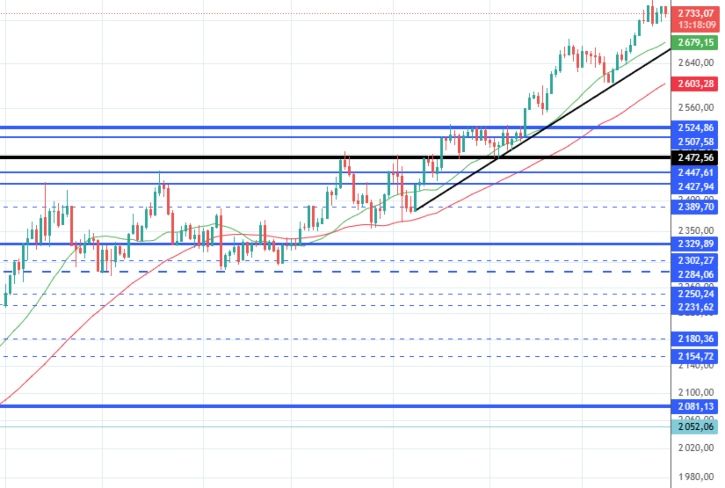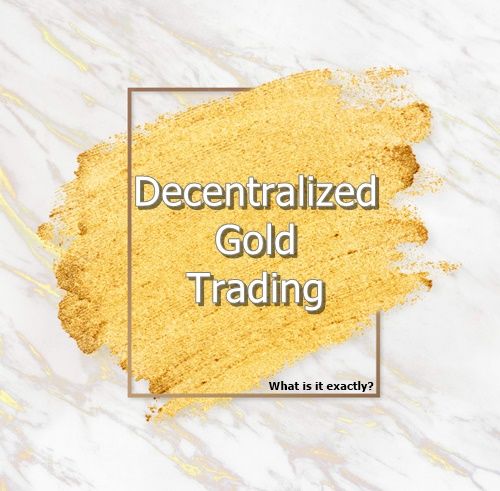Decentralized gold trading, what is it exactly? Discover the principle of decentralized trading applied to gold, including concrete examples.
Decentralized gold trading refers to the process of buying and selling gold in a decentralized manner, using a blockchain network or other peer-to-peer (P2P) technology, without the need for a centralized intermediary or authority.
In a decentralized gold trading system, buyers and sellers can interact with each other directly without the need for a traditional exchange or brokerage. Instead, they can use a decentralized platform or smart contract to exchange gold assets, such as gold bullion, gold coins, or gold-backed tokens, in a secure and transparent way.
Decentralized gold trading can offer several benefits over traditional gold trading systems, such as lower transaction costs, faster settlement times, greater privacy and security, and more accessibility to a wider range of investors.
Additionally, decentralized gold trading can help to eliminate counterparty risk, as all transactions are recorded on a public blockchain ledger, and the gold assets are usually stored in secure, audited vaults.
Decentralized gold trading, practical examples:
Aurus: Aurus is a blockchain-based platform that allows users to trade physical gold-backed tokens. The Aurus platform is powered by the Ethereum blockchain and allows users to trade gold assets directly without the need for a centralized authority. Aurus provides its users with real-time gold prices, secure vault storage, and the ability to redeem their tokens for physical gold.
Tether Gold: Tether Gold (XAUt) is a gold-backed token that is pegged to the price of gold and traded on the Ethereum blockchain. Each XAUt token is backed by one troy ounce of gold, held in a secure vault in Switzerland. Tether Gold allows investors to buy and sell gold in a decentralized manner, with the added benefit of being able to trade fractional amounts of gold.
DGLD: DGLD is a gold-backed token that is issued by CoinShares in partnership with MKS (Switzerland) SA. Each DGLD token is backed by one-tenth of a troy ounce of gold, held in a fully-audited vault in Switzerland. DGLD allows investors to buy and sell gold in a decentralized manner, while also providing the ability to redeem the tokens for physical gold.
Paxos Gold: Paxos Gold (PAXG) is another gold-backed token that is traded on the Ethereum blockchain. Each PAXG token is backed by one troy ounce of gold, held in a secure vault in London. Paxos Gold allows investors to buy and sell gold in a decentralized manner, with the added benefit of being able to redeem the tokens for physical gold.
Gains Trade: decentralized trading platform – Cryptos, Forex, Gold, Silver, Oil, Palladium, Platinum.
When you’re decentralized trading, and all the more so when you’re using leverage, you need to follow technical analysis on a regular basis, so that you know which prices to watch out for, both on the upside and the downside.
Decentralized gold trading – the analysis in daily, fast and practical
Fundamental Analysis of Gold
The fundamental analysis of gold hinges on several key factors influencing its long-term price. Here are the main elements to monitor in 2024:
- Central Bank Policies: Decisions by the U.S. Federal Reserve (Fed) and the European Central Bank (ECB) regarding interest rates are crucial. The Fed has maintained higher interest rates to combat inflation, which temporarily weakened gold. However, the potential for medium-term rate cuts could boost demand for gold as investors seek protection against inflation.
- Global Inflation: Inflationary concerns remain a central driver of gold demand. With persistent inflation in several major economies (U.S., Europe), gold is increasingly seen as an effective hedge against currency devaluation.
- Geopolitics and Economic Crisis: Gold is traditionally considered a safe haven during times of geopolitical tension or economic instability. In 2024, tensions between major powers, particularly the U.S., China, and Russia, continue to support gold demand.
- Physical Demand: Physical demand for gold (bullion, coins) is also rising, particularly in China and India, where gold is a key part of savings and tradition. This strong demand contributes to long-term price support.
Gold Market Analysis: Current Trends and Key Levels

Technical Analysis
Recent charts show that gold is within a bullish channel, currently consolidating in the price range of $2,710 to $2,760.
General Trend
Gold is in an upward trend. If we follow the support of the bullish channel, a return to this level, which also corresponds to the 20-day moving average (MA20), is possible.
Support and Resistance Levels
- Main Support: $2,710 USD
- Immediate Resistance: $2,760 USD
Moving Averages
The daily MA20 remains well above the MA50, which is still bullish.
Prices to Watch
- $2,760 USD: A breakout above this « pivot price » could trigger a new positive momentum towards $2,800 USD and beyond.
- $2,710 USD: If this support level is broken downwards, gold could test a lower support around $2,680 USD.
Conclusion
Gold continues to be a solid safehaven asset in 2024, supported by inflation fears, geopolitical tensions, and monetary policies. Both fundamental and technical analysis suggest a continuation of the medium-term bullish trend, with key resistances to watch around $2,800 USD.
Direct access to the decentralized trading platform
Information and conclusion:
It is possible to trade without sending your funds to a centralized trading platform by simply choosing a decentralized trading platform. The latter allows trading without brokers, without registration, while always keeping control of your assets, adhering to the true principles of decentralization. A prime example of this is the platform gains.trade, which enables you to easily place trades using your Metamask account, for instance.
In summary, these decentralized gold trading platforms allow investors to buy and sell gold assets in a secure, transparent, and efficient manner without the need for a centralized intermediary. By utilizing blockchain technology, investors can enjoy lower transaction fees, faster settlement times, and increased accessibility to gold investments.
Community of experienced traders in the Forex, commodities and crypto markets, offering articles to help you learn about trading through: relevant information – technical and fundamental analysis. Specificity: specialized in decentralized trading.
Communauté de traders expérimentés sur les marchés du Forex, matières premières, cryptos, offrant des articles permettant de s’éduquer au trading à travers : information pertinente – analyse technique et fondamentale. Spécificité : spécialisé dans le trading décentralisé.
